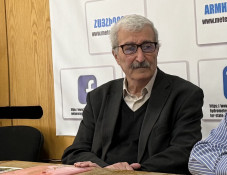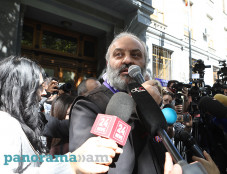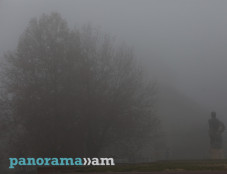
Sumgait is epicenter of Wahhabism in Azerbaijan, where in 1988 they demanded not ‘‘bread and meat’’ but blood of Armenians
Imamism as а direction of traditional Shiism in Azerbaijan seems to be on the way to extinction. Salafism in the form of jihadism comes to replace it. This is stated in the article titled "The causes of extension of religious radicalism in Azerbaijan", published on the website of the "Scientific Society of Caucasus Studies."
As noted in the article, the experts have long noticed a direct correlation of growth of "jihadist" attitudes based on several other factors: socio-economic instability, social and wealth inequality, corruption and deprivation of cultural values in the population. Radical Salafism was just doomed to success in Azerbaijan, which is in the top ten on the list where all the above mentioned parameters are present.
The author writes that one of the reasons why popularity of Salafism grows in Azerbaijan can be found in the fact that the ruling movement is in monopole position. In the Azerbaijani realities, the relation of people and the law is perceived exclusively through government corruption and police repression.
The article states that the institutional weakness of the ruling party "Yeni Azerbaijan" does not allow it to be in equal competition with other parties of the country. That is why the leadership of "Yeni Azerbaijan" party, together with its controlled security forces of Azerbaijan, creates a climate in the country where any real multiparty democracy withers. When the ruling elite is in self-isolation from its own people, who, in their turn, are deprived of opportunity to influence the life in their own country, then there is one logical outcome - radical protest moods within the grassroots.
"At the beginning of the XX century the oppressed lower classes of Azerbaijan were inspired with the Marxism in Lenin’s version. At the end of the XX and the beginning of XXI centuries radical Salafism became the "Marxism" of Azerbaijan. In other words, Wahhabism. Just as Marxists, the Azerbaijani Wahhabis too do not recognize any attributes of bourgeois democracy (the constitution, parliament, elections)," the author writes, and notes that Wahhabism in Azerbaijan has turned into the "new "Marxism-Leninism" with the pure Islam" in the forefront.
According to the author, the main hubs of Wahhabism in Azerbaijan are at the crisis cities and regions of the republic. According to experts, the leading epicenter in this respect is the city of Sumgait.
"In Sumgait, until the collapse of the Union, there were no centers of cultural activities, and no production, except "chemistry", i.e. petrochemical "harmful" productions. The bulk of the population that was engaged in "harmful" production", lived mainly in barracks and basements, and some of the workers huddled in "nahalstroi” (illegal construction)", makeshift shacks on the outskirts of the city. Those days are gone, Azerbaijan has became independent, but the "nahalstroi" in the republic has remained," the material states.
Sumgait was the worst one in provision of consumer’s goods in the USSR. In the 1950s - 1960s the central city square was regularly shaken by the demonstrations of oilmen, demanding bread, meat, and housing with running water” from the authorities. During the reign of Heydar Aliyev over the Soviet Azerbaijan, protest activity of the Sumgait residents moved from the streets and squares to the kitchens and backyards. This procedure preserved during the reign of Aliyev’s successor Kamran Bagirov.
“It’s likely that the fear from the KGB of Azerbaijani SSR played its prominent role. In fact, when Aliyev and Baghirov held the power, KGB became the only authority in the country. The protests in Sumgait were re-launched in 1988, however people in the streets in 1988 instead of “bread and meat” longed for blood, Armenian blood…” the author writes.
According to the author Salafism in Sumgait is linked with the other ethno-regional phenomenon, born in the North and North-West of the republic. Some sources call it “Lezgian Salafism”. “In early and mid 90s the Lezgis, particularly from the regions of Zakatali, Khamchazi and Gusar held a dominant role in spread of Wahhabism. “Lezgian Salafism” in Azerbaijan is primarily associated with Ilhar Molachiev, famous Wahhabi from Azerbaijani region of Zakatali,” Azerbaijani famous scholar of Oriental Studies, Arif Yunusof said.
According to some experts jihadism of the Lezgi-Avar geographical area is associated with the jihadism of Sumgait, while Molachiev is one of the manifestations of this relationship. Close ties of these regions can be explained by the similarity of ethnic maps. The majority of the population of Zakatali region is Lesgis, people speaking Lezgian language and Avars. Sumgait now has a lot of Lezgis, Rutuls and Tsakhurs. They mainly work at the inferior “dirty” positions in the oil industry of Azerbaijan.
“The researchers believe that Sufi Sheikhs of Dagestan perceive the national policy of Azerbaijan as a cultural genocide of non-Turkic peoples, and that is why Baku looks at their visits to the country as potential attacks on the existing regime. Wherever Baku encounters Sufi activity, security forces carry out repressions towards that Sufis. In some regions of Azerbaijan, particularly in Nakhijevan the Sufis completely went underground,” reads the article.
The author states that the recasting of ethnic groups in Azerbaijan is very often the result of forced assimilation and Turkification. The main components of such a “melt-down” are the reformation of cultural turkificated individual and its subsequent cultural marginalization. The results may differ but very often “assimilation conveyer” release only two types of “products”, either obedient mankurts or deprived of values rebels. Jihadists, as a rule, belong to the second type of the above mentioned “products of assimilation.” Besides, the situation in Azerbaijan is intensifying as there is no clear idea of Azerbaijani nation.
The author notes that the jihadists’ impact on society grows in parallel with the growing repressions of Azerbaijani government towards the Muslims. It turns out that Baku itself drives the country into a vicious circle: the more Azerbaijani authorities would chase the jihadists, the more influence the jihadists would have on the country.
“Baku is particularly concerned with the fact that the usual methods (putting Islamists into jail) of jihadism neutralization don’t work. Moreover, they stimulate the religiously motivated protest moods due to so called “prison jihad phenomenon.” “After leaving the prison the young jihadists start spreading their ideas among the younger generation of “depressed” industrial suburbs,” the author said meanwhile stating that instead of tackling jihadism basically and fully, Baku either “pushes its jihadists out of the country” or kills them during armed operations.
Newsfeed
Videos






























